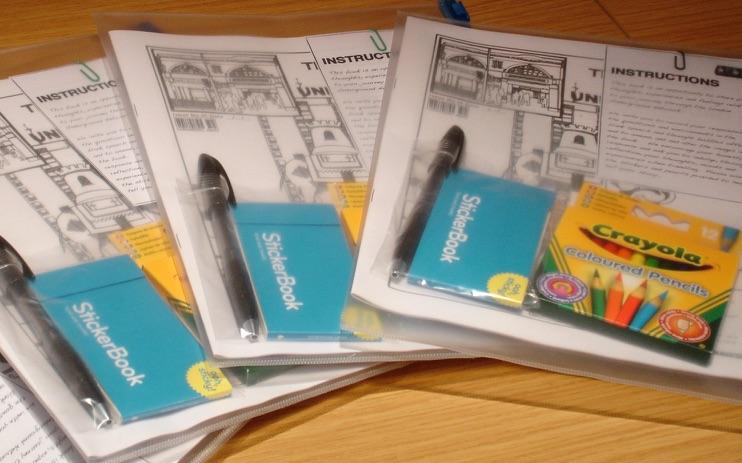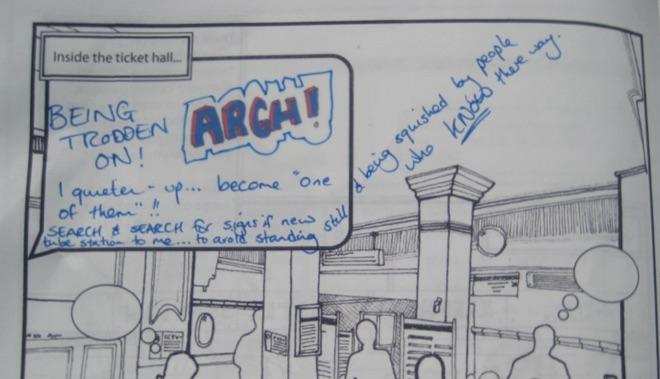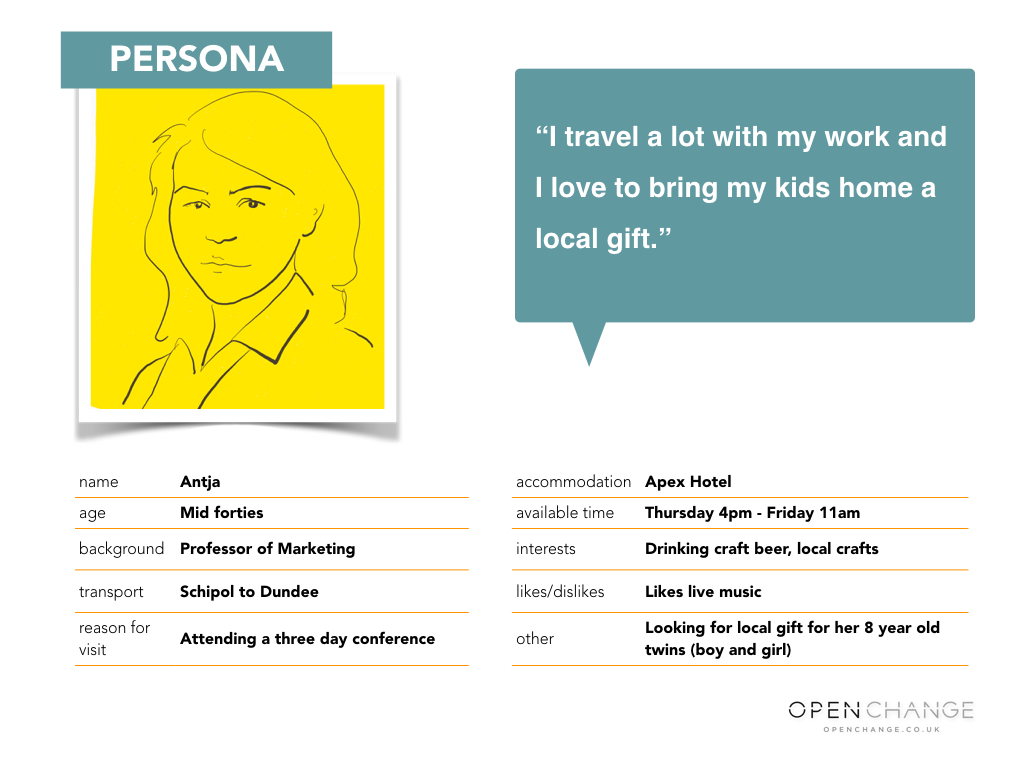Module 3 - Section 4
User Research

A couple of years after the London Tube bombings, Mike Press - a Dundee- based design researcher - was commissioned to investigate the attitudes and feelings of Londoners travelling on the Tube. Some large-scale focus groups were carried out, but these did not seem to be telling the whole story of how people felt. So he conducted a cultural probe study. It was a ‘user diary’ which took the form of a hand-drawn comic style book for people to record their feelings using pens, crayons and specially produced stickers.

This provided much richer, detailed and emotive views of the travelling experience, and contributed unique data to the study. Design researchers in Oslo were also interested in how people used the city's subway system, but in this case they were interested in the specifics of how people navigated it. So here participant observation was the best method to use.

We have a huge range of methods at our disposal that help us to understand users. As Andrew Polaine, Lavrans Lovlie and Ben Reason explain in their book Service Design: from insight to implementation:
"Service design draws upon the user- and human-centred design traditions as well as the social sciences to form the basis of our work gathering insights into the experiences, desires, motivations, and needs of the people who use and provide services."
Let us begin by watching Angela Collins-Rees, a specialist working for the UK Government Digital Service, explain briefly what is user research?
So, Angela gives us some idea of the range of methods, the kinds of
situations you may use different methods, and the vital need to know
your user! As she also reveals, user research can also be fun!
Two members of the Government Digital Service team - Cath Richardson
and Jon Rimmer - talk about some of the user research methods they
are using at GDS:
The short video link above refers to their User Research
Activity Cards - a very useful resource that gives you an even
broader view of the user research methods at your disposal. You
may find these useful to download:
User Research
Let us begin by watching Angela Collins-Rees, a specialist working for the UK Government Digital Service, explain briefly what is user research?
Two members of the Government Digital Service team - Cath Richardson and Jon Rimmer - talk about some of the user research methods they are using at GDS:
Personas
Let us now look at another tool that is vital for UX designers -
personas.
Personas are a series of fictitious characters created to represent
different groups of people. Each persona is based on interviewing real
people and bringing together their characteristics, experiences and
needs.
A persona gives us a believable, but anonymous, character to design
for. One of the most important reasons to create personas is for
everyone to share a common understanding of the range of people who
you support. This helps your organisation meets everyone’s needs,
rather than a ‘one size fits all’ experience that suits the people
running the organisation.
Personas provide a range of different perspectives on your project or
organisation and the service you provide. It helps you and your team
focus on others, rather than designing for yourself, the loudest
person in the room or the most senior person in the room (often the
loudest too). Anonymity is important – sometimes people simply don’t
want their friends, family or employers to know what they have spoken
about.
Going through a real example will help show how to develop them, how
they work and what they can show. A recent project was looking at how
the City of Dundee could develop new experiences for the tourist
economy. Drawing on data regarding tourism and semi- structured
interviews with visitors (and non visitors) a range of personas were
developed.


These are two are taken from a number that were developed. The
personas helped gain some insights into attracting specific types of
visitors.
In a workshop recently conducted with social enterprises we asked
participants to develop personas of their users. In most cases people
used informal meetings of work colleagues to develop these, as shown
bellow.
Here are some things to keep in mind when developing and using personas:
- Personas are fictional characters but should be based on real insight from an existing user groups – go and talk to people.
- People relate to people. Using personas helps people to relate to their character, their life, their emotions and their journey.
- They are a great way of telling a story about your project through a human story whilst preserving people’s anonymity.
- This ensures that the user (existing or future) is always at the heart of what you design.
Here is a quick six minute video about the 'Wellbeing Map' project, commissioned by the NHS (North West London) as a pilot initiative in White City, London to identify the best ways of signposting residents to local services. This shows how the methods we have been considering can all come together. Here, personas are used to inform the approach taken.
Transport for London is one of the world’s largest and most complex
transport providers with an annual budget of £11.5 billion. The
organisation is constantly innovating, shifting towards online
service delivery and embedding design within its processes. Indeed,
from the 1920s onward, London Transport has been hailed as an
exemplar of design management. More recently TfL has used service
design to embed mobile technologies into the workday practices of
its 29,000 employees who serve millions of tube and bus passengers
each day. Just one element of this - a fault reporting app - is
estimated to save 20,000 person hours each year. Take a look at its
Digital Toolkit for its designers and contractors. See how they use
the principles and methods we have been exploring, and in particular
their use of personas:
https://tfl.gov.uk/info-for/suppliers-and-contractors/digital-design-toolkit/understanding-our-users
The TfL personas were very detailed - certainly more so than in the
examples we have seen so far. What we include in a persona really
depends on what project we are researching. Personas are generally
based on a particular mix of each character’s behaviours, habits,
needs, desires, attitudes and cultural background. Here is a persona
template you could use - http://www.openchange.co.uk/personas/ - but
a quick Google of ‘Persona Templates’ will quickly show the huge
variety. You decide what is important. Either use a template you can
download or (better still) design your own. This online tool helps
you to tailor a persona template to your specific needs: https://
xtensio.com/user-persona

Activity 8
Blog
You are asked to adopt an ethnographic approach in talking to
people who are potential users of your project. As you talk to
them find out what their attitudes to and experiences of online
learning are. Also discover some insights about their skill
levels and motivations. These may be people you work with, or
people you meet at a professional event. Please bear in mind -
you are not conducting a survey! You are seeking to identify a
breath of user experience and aspiration.
From this, create at least two personas of people who your
proposed project could support. One of them could be a member of
staff or volunteer. You could also develop a future persona –
someone who isn’t currently engaged with your project but who
you’d like to participate in the future.
Once you have done this, put together a 5-10 slide slide- deck
and upload this to your blog.